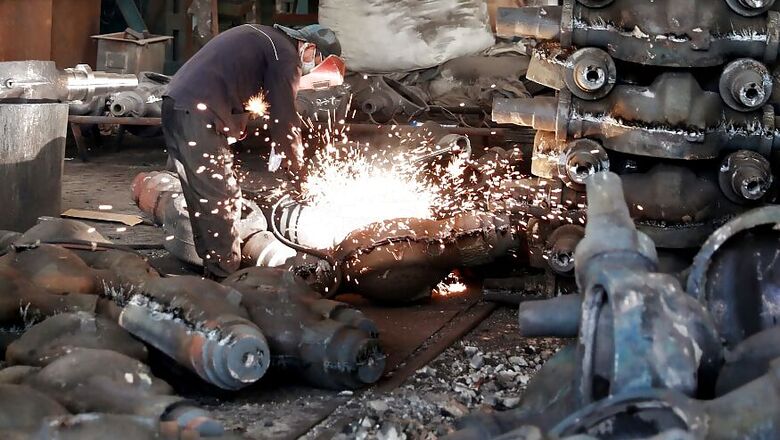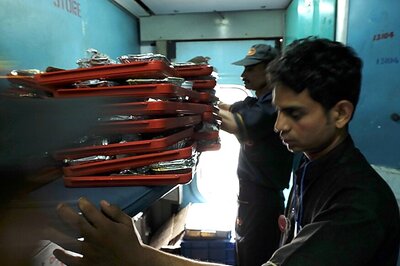
views
New Delhi: Delhi’s consumer electronics hub Gaffar Market is over 3,500km away from China. But that physical distance has not insulated traders here from the Coronavirus outbreak there.
Manoj Kansal, a cellphone trader, is worried about how the next few weeks would be. Almost all the inventory he stocks uses components imported from manufacturing zones in China.
With no trading for the last three months — first due to the extended Lunar New Year celebrations and then the COVID 19 outbreak — the supply of fresh inventory remains uncertain
"Apple has only two units —some models are made in China and some in India. Whatever is made in China is running short of supply all over the world. This is because the sourcing is only from China," says Kansal.
Many other traders here say the real financial impact of the outbreak on their business would be clear only by March.
Meanwhile, India’s largest wholesale market for household items, Sadar Bazaar, usually flooded with Chinese goods or products that rely on components imported from China, is also staring at a crisis.
The supply of televisions that use up to 75% and smart phones that use up to 85% Chinese components is going to be hit. Critical components such as mobile displays, open-cell TV panels, open-circuit boards and memory and LED chips are all imported from China.
Even simple products that can be easily made locally are imported because that’s cheaper.
"These spare parts have great finishing, but no one wants to make it here. Once made here, the costs will increase. It suits us to buy the same from China," says Gourav Arora, a wholesaler of electronic goods in Delhi's Old Lajpat Rai Market.
The disruption in the supply chain is starting to have an inflationary impact on consumers.
Japanese AC-maker Daikin has already informed retailers that the company will be increasing prices between 3-5% from February. Mobile phone companies are also doing away with the big discounts they offer on e-commerce platforms.
"When I get stocks at a non-discounted rate, I will sell it to the customer on that non-discounted rate. I am sure the customer won’t be happy because the same product will be sold at a higher price. It is obvious that I will incur losses," says Kansal.
The impact is expected to be felt on essential commodities like medicines as well. The price of China-imported Paracetamol has already shot up by 40%. India imports 70% of bulk medicines or raw materials for medicines from the country.
As a contingency measure, traders have appealed to Finance Minister Nirmala Sitharaman to intervene and airlift raw materials from China.
"The increase in the prices of raw materials have been announced. The industry will have to bear the costs. The distributor will charge a higher sum from us. We will also have to sell it at a higher rate — a 10-15 % or even 20% increase — to customers,” says Asish Grover, a trader at Bhagirath Palace.
The impact on trade is directly affecting labourers employed by assembly units that import Chinese components. Many may soon become jobless.
"It is a big problem and loss for labourers. The routine will be disrupted. The transporter hires labourers to load and unload. All these people will be impacted," says Dev Raj Baweja, a trader at Sadr Bazaar.
China is the largest trading partner for India accounting for 15% of total imports and it has been hit hard. For example, the price of raw cotton has slipped by Rs 200-300 below the minimum support price in India, as there is a squeeze in demand from China.
India’s exports in January 2020 fell by 1.66% and imports dropped by 0.75%. The government has held several rounds of meetings with stakeholders, but is yet to announce contingency measures.
Industry players say this is the time for the government to handhold the industry, especially small traders, and work towards emerging as an alternative manufacturing destination.
"We have been talking about opportunities ever since the China-US trade war broke out. We thought investments would come here, but that did not happen? They went elsewhere — to places like Vietnam or even Mexico. We need a proactive government which takes control of the situation," says trade analyst Biswajit Dhar.
"The MSME sector, in particular, is badly affected and their concerns should be looked into. There should be sometime for the payback of loans and other dues. The sector requires a lot of help. Facilities for soft loans should be there. The government needs to do this in a time-bound manner," says SK Saraf, president of the Federation of Indian Export Organisation.
One can also come across traders who are cashing upon the opportunity created out of the crisis. Mohammad Arshad, a wholesale trader, says this is a blessing in disguise.
"Goods are not being imported because of the virus in China. We want Indian products to be sold in India. This is for our progress. China had ruined the market. For example, things that cost Rs 17 when made in India are sold at Rs 10 when imported from China. Our work was affected," says Arshad.
Experts are weighing in India’s options. The Economic Survey suggests integrating ‘Make in India’ with an ‘assemble for the world’ plan, taking a leaf out of the Chinese model.
“Our similarities with China in terms of our labour force give us an edge. This should also serve as a wake-up call,” says a trader.
"It is for us to see now, that for any reason, if any country stops trade with India, what do we do. This is our chance at taking the ‘make in India’ initiative ahead," says NK Goyal, president of the Cellular Manufacturers Association of India.
Rise in positive cases and deaths due to the virus not just in China, but several other countries, including in the middle east, Japan and South Korea, with whom India has deep trading ties, is grim news especially at a time when the country is struggling to get the economy back on track and fight unemployment.




















Comments
0 comment